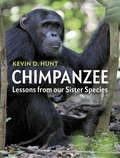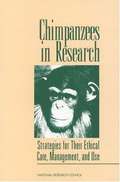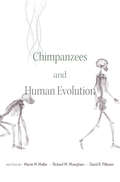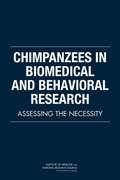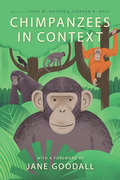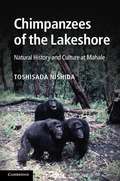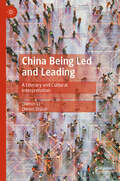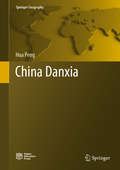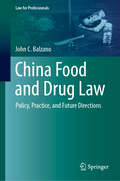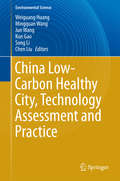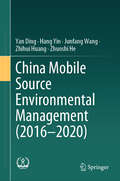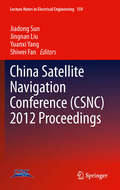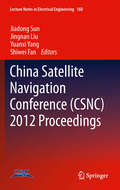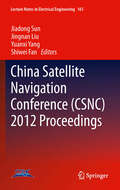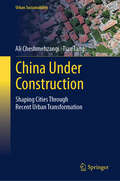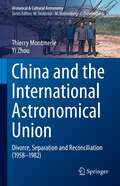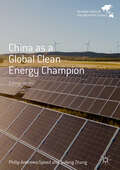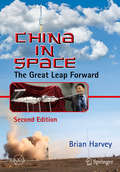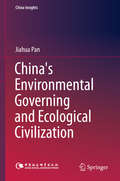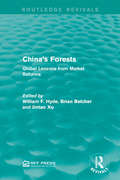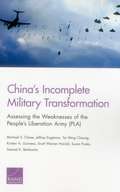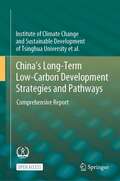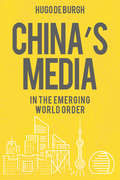- Table View
- List View
Chimpanzee: Lessons from our Sister Species
by Kevin D. HuntThe chimpanzee is one of our planet's best-loved and most instantly recognisable animals. Splitting from the human lineage between four and six million years ago, it is (along with its cousin, the bonobo) our closest living relative, sharing around 94% of our DNA. First encountered by Westerners in the seventeenth century, virtually nothing was known about chimpanzees in their natural environment until 1960, when Jane Goodall travelled to Gombe to live and work with them. Accessibly written, yet fully referenced and uncompromising in its accuracy and comprehensiveness, this book encapsulates everything we currently know about chimpanzees: from their discovery and why we study them, to their anatomy, physiology, genetics and culture. The text is beautifully illustrated and infused with examples and anecdotes drawn from the author's thirty years of primate observation, making this a perfect resource for students of biological anthropology and primatology as well as non-specialists interested in chimpanzees.
Chimpanzees In Research: Strategies For Their Ethical Care, Management, And Use
by Committee On Long-term Care Of ChimpanzeesThe National Academies Press (NAP)--publisher for the National Academies--publishes more than 200 books a year offering the most authoritative views, definitive information, and groundbreaking recommendations on a wide range of topics in science, engineering, and health. Our books are unique in that they are authored by the nation's leading experts in every scientific field.
Chimpanzees and Human Evolution
by Martin N. MullerKnowledge of wild chimpanzees has expanded dramatically. This volume, edited by Martin Muller, Richard Wrangham, and David Pilbeam, brings together scientists who are leading a revolution to discover and explain human uniqueness, by studying our closest living relatives. Their conclusions may transform our understanding of human evolution.
Chimpanzees in Biomedical and Behavioral Research
by Bruce M. AltevogtFor many years, experiments using chimpanzees have been instrumental in advancing scientific knowledge and have led to new medicines to prevent life-threatening and debilitating diseases. However, recent advances in alternate research tools have rendered chimpanzees largely unnecessary as research subjects. The Institute of Medicine, in collaboration with the National Research Council, conducted an in-depth analysis of the scientific necessity for chimpanzees in NIH-funded biomedical and behavioral research. The committee concludes that while the chimpanzee has been a valuable animal model in the past, most current biomedical research use of chimpanzees is not necessary, though noted that it is impossible to predict whether research on emerging or new diseases may necessitate chimpanzees in the future.
Chimpanzees in Context: A Comparative Perspective on Chimpanzee Behavior, Cognition, Conservation, and Welfare
by Lydia M. HopperThe study of the chimpanzee, one of the human species’ closest relatives, has led scientists to exciting discoveries about evolution, behavior, and cognition over the past half century. In this book, rising and veteran scholars take a fascinating comparative approach to the culture, behavior, and cognition of both wild and captive chimpanzees. By seeking new perspectives in how the chimpanzee compares to other species, the scientists featured offer a richer understanding of the ways in which chimpanzees’ unique experiences shape their behavior. They also demonstrate how different methodologies provide different insights, how various cultural experiences influence our perspectives of chimpanzees, and how different ecologies in which chimpanzees live affect how they express themselves. After a foreword by Jane Goodall, the book features sections that examine chimpanzee life histories and developmental milestones, behavior, methods of study, animal communication, cooperation, communication, and tool use. The book ends with chapters that consider how we can apply contemporary knowledge of chimpanzees to enhance their care and conservation. Collectively, these chapters remind us of the importance of considering the social, ecological, and cognitive context of chimpanzee behavior, and how these contexts shape our comprehension of chimpanzees. Only by leveraging these powerful perspectives do we stand a chance at improving how we understand, care for, and protect this species.
Chimpanzees of the Lakeshore
by Toshisada NishidaChimpanzees are humanity's closest living relations and are of enduring interest to a range of sciences, from anthropology to zoology. In the West, many know of the pioneering work of Jane Goodall, whose studies of these apes at Gombe in Tanzania are justly famous. Less well-known, but equally important, are the studies carried out by Toshisada Nishida on the eastern shore of Lake Tanganyika. Comparison between the two sites yields both notable similarities and startling contrasts. Nishida has written a comprehensive synthesis of his work on the behaviour and ecology of the chimpanzees of the Mahale Mountains. With topics ranging from individual development to population-specific behavioural patterns, it reveals the complexity of social life, from male struggles for dominant status to female travails in raising offspring. Richly illustrated, the author blends anecdotes with powerful data to explore the fascinating world of the chimpanzees of the lakeshore.
China Automotive Low Carbon Action Plan (2022): Low Carbon Development Strategy and Transformation Path for Carbon Neutral Automotive
by Automotive Data of China Co., LtdThis book studies the low-carbon transformation path of the automotive industry. It makes a quantitative analysis of the emission reduction potential of the transformation path based on the systemic accounting of the carbon emissions in the whole life cycle of automobiles. The content puts forward scientific and reasonable suggestions on Chinese automobiles' low-carbon development strategy and transformation path.This book is used as a reference for professionals in the automotive industry who are engaged in automotive life cycle assessment, carbon footprint research, carbon neutrality planning research, etc. It is also used as a reference book for students in automotive in universities.
China Being Led and Leading: A Literary and Cultural Interpretation
by Daniel Braun Zhimin LiThis book unearths a forgotten history of exchange and enlightenment between China and the West, told through vivid examples drawn from the world of poetry, the philosophy of culture and religion, and the realm of international communication. Across chapters that cover an extraordinary range of cultural terrain, from an examination of the parallel expatriate experiences of the British critic and poet William Empson and the Chinese writer Xu Zhimo, to a study of the influence of Christian thought on the evolution of Confucianism, authors Li Zhimin and Daniel Braun rethink the contemporary paradigm of western hegemony and international division that shapes our senses and studies of the East and the West alike, in order to present an image of modern China that is richly hybrid in its blend of cultures, histories, and traditions. This book is immersed in the cultures and literary traditions of China and the West, and written for specialists of the regions and general interest readers alike.
China Danxia (Springer Geography)
by Hua PengThis book presents the major research advances relating to Chinese Danxia landforms over the past 80 years. It covers geological setting, morphologic characteristics and evolution, biology and ecology, aesthetic value and earth science value, and briefly introduces the six heritage sites, enabling readers to gain a systematic understanding of Danxia landform theories and the China Danxia World Heritage sites.
China Food and Drug Law: Policy, Practice, and Future Directions (Law for Professionals)
by John C. BalzanoThis book is an analysis of policy and law governing the development, approval, manufacture, distribution, marketing and post-market surveillance of human drugs, medical devices, foods and cosmetics in Mainland China (“China FDD Regulation”). It analyzes the policy and general principles behind China FDD Regulation, including the history and jurisdiction of the central and local agencies that administer the laws and regulations, the administrative law structure in which these agencies operate, and other aspects of FDD Regulation interpretation and enforcement. Although it describes practice in China, this book is written in the comparative perspective (i.e., sensitive to assumptions made by those who are steeped in FDD Regulation in the U.S., Japan, and the EU). It includes one chapter on each regulatory space (drugs, medical devices, cosmetics, and food) organized by the lifecycle of products. It also covers subcategories of products, such as vaccines, radiopharmaceuticals, and in vitro diagnostic medical devices. The book includes specialty chapters on areas that are common to multiple types of regulated products, such as biosecurity and advertising. It is the first English language book of its kind, and it can serve as a resource for those in the FDD law and regulatory field to understand the mechanics of developing and marketing products, but also with insights for businesspeople and others, who are developing China-strategies.
China Low-Carbon Healthy City, Technology Assessment and Practice (Environmental Science and Engineering)
by Song Li Jun Wang Weiguang Huang Mingquan Wang Kun Gao Chen LiuThis book is based on multidisciplinary research focusing on low-carbon healthy city planning, policy and assessment. This includes city-development strategy, energy, environment, healthy, land-use, transportation, infrastructure, information and other related subjects. This book begins with the current status and problems of low-carbon healthy city development in China. It then introduces the global experience of different regions and different policy trends, focusing on individual cases. Finally, the book opens a discussion of Chinese low-carbon healthy city development from planning and design, infrastructure and technology assessment-system perspectives. It presents a case study including the theory and methodology to support the unit city theory for low-carbon healthy cities. The book lists the ranking of China's 269 high-level cities, with economic, environmental, resource, construction, transportation and health indexes as an assessment for creating a low-carbon healthy future. The book provides readers with a comprehensive overview of building low-carbon healthy cities in China.
China Mobile Source Environmental Management (2016—2020)
by Yan Ding Hang Yin Junfang Wang Zhihui Huang Zhuoshi HeMobile source pollution has become an important source of air pollution in large and medium-sized cities in China, and it also causes particulate matter and photochemical smog pollution. This book introduces the mobile source law, regulation and standards policy system. It presents a panoramic view of China's achievements in mobile source environmental management. It also reviews latest energy-saving and emission reduction technologies to provide reference for all sectors of society to gain a deeper understanding of mobile source environmental management.
China Satellite Navigation Conference: The 3rd China Satellite Navigation Conference (csnc): Guangzhou, China, May 15-19, 2012: Revised Selected Papers (Lecture Notes in Electrical Engineering #159)
by Jiadong Sun Jingnan Liu Shiwei Fan Yuanxi YangProceedings of the 3rd China Satellite Navigation Conference (CSNC2012) presents selected research papers from CSNC2012, held on 15-19 May in Guanzhou, China. These papers discuss the technologies and applications of the Global Navigation Satellite System (GNSS), and the latest progress made in the China BeiDou system especially. They are divided into 9 topics to match the corresponding sessions in CSNC2012, which broadly covered key topics in GNSS. Readers can learn about the BeiDou system and keep abreast of the latest advances in GNSS techniques and applications. SUN Jiadong is the Chief Designer of the Compass/BeiDou system, and the Academician of Chinese Academy of Sciences; LIU Jingnan is a professor at Wuhan University, and the Academician of Chinese Academy of Engineering; YANG Yuanxi is a professor at China National Administration of GNSS and Applications, and the Academician of Chinese Academy of Sciences; FAN Shiwei is a researcher on satellite navigation.
China Satellite Navigation Conference: The 3rd China Satellite Navigation Conference (csnc): Guangzhou, China, May 15-19, 2012: Revised Selected Papers (Lecture Notes in Electrical Engineering #160)
by Jiadong Sun Jingnan Liu Shiwei Fan Yuanxi YangProceedings of the 3rd China Satellite Navigation Conference (CSNC2012) presents selected research papers from CSNC2012, held on 15-19 May in Guanzhou, China. These papers discuss the technologies and applications of the Global Navigation Satellite System (GNSS), and the latest progress made in the China BeiDou system especially. They are divided into 9 topics to match the corresponding sessions in CSNC2012, which broadly covered key topics in GNSS. Readers can learn about the BeiDou system and keep abreast of the latest advances in GNSS techniques and applications. SUN Jiadong is the Chief Designer of the Compass/BeiDou system, and the Academician of Chinese Academy of Sciences; LIU Jingnan is a professor at Wuhan University, and the Academician of Chinese Academy of Engineering; YANG Yuanxi is a professor at China National Administration of GNSS and Applications, and the Academician of Chinese Academy of Sciences; FAN Shiwei is a researcher on satellite navigation.
China Satellite Navigation Conference: The 3rd China Satellite Navigation Conference (csnc): Guangzhou, China, May 15-19, 2012: Revised Selected Papers (Lecture Notes in Electrical Engineering #161)
by Jiadong Sun Jingnan Liu Shiwei Fan Yuanxi YangProceedings of the 3rd China Satellite Navigation Conference (CSNC2012) presents selected research papers from CSNC2012, held on 15-19 May in Guanzhou, China. These papers discuss the technologies and applications of the Global Navigation Satellite System (GNSS), and the latest progress made in the China BeiDou system especially. They are divided into 9 topics to match the corresponding sessions in CSNC2012, which broadly covered key topics in GNSS. Readers can learn about the BeiDou system and keep abreast of the latest advances in GNSS techniques and applications. SUN Jiadong is the Chief Designer of the Compass/BeiDou system, and the Academician of Chinese Academy of Sciences; LIU Jingnan is a professor at Wuhan University, and the Academician of Chinese Academy of Engineering; YANG Yuanxi is a professor at China National Administration of GNSS and Applications, and the Academician of Chinese Academy of Sciences; FAN Shiwei is a researcher on satellite navigation.
China Under Construction: Shaping Cities Through Recent Urban Transformation (Urban Sustainability)
by Ali Cheshmehzangi Tian TangAs a continuation of our award-winning book, ‘China's City Cluster Development in the Race to Carbon Neutrality’ and our recent book, ‘30 Years of Urban Change in China’s 10 Core Cities’, this book delves into China's recent progress in reshaping its cities through holistic urban transformation strategies. Building on our previous work, we expand our focus to explore the latest developments in urbanization, examining how recent strategies and policies have influenced cities and cityscapes across China and beyond. It is evident that China is reshaping its cities through a dynamic interplay of policy reforms, technological advancements, and creative planning. The late 20th and early 21st centuries have seen a sharp increase in urbanization, with a particular focus on the development of smart, resilient, and sustainable cities. Through a thorough examination of case study examples that have undergone significant recent change, this book investigates how these goals are being achieved. ‘China Under Construction: Shaping Cities through Recent Urban Transformation’ offers a thorough overview of China's current urban transformation efforts, highlighting both the achievements and the ongoing challenges, through case studies and in-depth evaluations. We hope to provide insightful information about the real-world applications of urban strategies and their wider implications for China's future urban landscape by concentrating on ten selected cities. This extension of our earlier research emphasizes how critical it is to view urban transformation as a complex process influencing social dynamics, technology, infrastructure, and environmental sustainability, among other facets of city life and urbanization.
China and the International Astronomical Union: Divorce, Separation and Reconciliation (1958–1982) (Historical & Cultural Astronomy)
by Thierry Montmerle Yi ZhouSeen from “inside the IAU,” this book tells the in-depth story of a major crisis in which China “divorced” from the International Astronomical Union in 1960 as a protest against the admission of Taiwan. This happened to all the scientific unions at the same time, and to the Olympic Games, which, unexpectedly, would serve as a laboratory for the “reconciliation” which took place following the re-opening of China to the world 20 years later.The so-called “China conflict” is the most important crisis in the post-WWII history of the IAU. Yet, many details about this conflict and its links to broader geopolitical events have long remained unsettled, obscure, or altogether absent. In particular, the book describes for the first time the “separation” period, which covered the Cultural Revolution, and in which the IAU made desperate official efforts to reach out to China, while some groups of Western and Chinese astronomers managed to keep contact at times. On the occasion of the IAU Centenary celebrations in 2019, the book revisits this painful succession of events using unpublished documents from the IAU Archives and the International Council of Scientific Unions. The book also contains supplementary typescripts of selected handwritten correspondences and the full translation of key original Chinese documents unknown to readers outside China.What emerges is a complex and fascinating story of human relations and science diplomacy under the shadow of the Cold War. Readers will learn how the 20-year “China conflict” as lived by astronomers and scientists is important not only for the history of the IAU, but also for the history of contemporary China. “This book is full of so many original documents of the IAU office, very reliable and good to open to the public readers.” Shuhua Ye, Shanghai Observatory (IAU Vice-President, 1988-1994)This book is a companion book to "Astronomers as Diplomats," published at the same time in the same series.
China as a Global Clean Energy Champion: Lifting the Veil (Palgrave Series in Asia and Pacific Studies)
by Philip Andrews-Speed Sufang ZhangThis book assesses China’s reputation as a global clean energy champion, and applies institutional and public policy theories to explain how the country has achieved so much and why there continue to be so many unintended consequences and constraints to progress. It considers the extent to which the government has successfully boosted the manufacture and deployment of low-carbon electricity generating infrastructure, cleaned up thermal power generation, and enhanced energy efficiency, dramatically constraining China’s rising carbon dioxide emissions, but also examines the substantial political and financial capital required to reinforce the predominantly administrative policy instruments and the mix of special interests and poor coordination that are endemic to the energy sector. Arguing that the current approach seems to be encountering ever diminishing returns, the book considers whether ongoing sector reforms and the new national emissions trading scheme can reinvigorate the nation’s clean energy trajectory.
China in Space: The Great Leap Forward (Springer Praxis Books)
by Brian HarveyIn 2019, China astonished the world by landing a spacecraft and rover on the far side of the Moon, something never achieved by any country before. China had already become the world’s leading spacefaring nation by rockets launched, sending more into orbit than any other. China is now a great space superpower alongside the United States and Russia, sending men and women into orbit, building a space laboratory (Tiangong) and sending probes to the Moon and asteroids. Roadmap 2050 promises that China will set up bases on the Moon and Mars and lead the world in science and technology by mid-century.China’s space programme is one of the least well-known, but this book will bring the reader up to date with its mysteries, achievements and exciting plans. China has built a fleet of new, powerful Long March rockets, four launch bases, tracking stations at home and abroad, with gleaming new design and production facilities. China is poised to build a large, permanent space station, bring back lunar rocks, assemble constellations of communications satellites and send spaceships to Mars, the moons of Jupiter and beyond. A self-sustaining lunar base, Yuegong, has already been simulated. In space, China is the country to watch.
China's Energy Revolution in the Context of the Global Energy Transition (Advances in Oil and Gas Exploration & Production)
by Shell International B.V. The Development Research Center (DRC) of the State Council of the People’s Republic of ChinaThis open access book is an encyclopaedic analysis of the current and future energy system of the world’s most populous country and second biggest economy. What happens in China impacts the planet. In the past 40 years China has achieved one of the most remarkable economic growth rates in history. Its GDP has risen by a factor of 65, enabling 850,000 people to rise out of poverty. Growth on this scale comes with consequences. China is the world’s biggest consumer of primary energy and the world’s biggest emitter of CO2 emissions. Creating a prosperous and harmonious society that delivers economic growth and a high quality of life for all will require radical change in the energy sector, and a rewiring of the economy more widely. In China’s Energy Revolution in the Context of the Global Energy Transition, a team of researchers from the Development Research Center of the State Council of China and Shell International examine how China can revolutionise its supply and use of energy. They examine the entire energy system: coal, oil, gas, nuclear, renewables and new energies in production, conversion, distribution and consumption. They compare China with case studies and lessons learned in other countries. They ask which technology, policy and market mechanisms are required to support the change and they explore how international cooperation can smooth the way to an energy revolution in China and across the world. And, they create and compare scenarios on possible pathways to a future energy system that is low-carbon, affordable, secure and reliable.
China's Environmental Governing and Ecological Civilization (China Insights)
by Jiahua PanThis book looks into the increasing conflict between the demand of economic growth and the already fragile ecological system condition in China. The prolonged urbanization process has escalated the erosion of natural environments and is increasing energy consumption. China's role as a "world plant" is also demanding more and more resource supply as well as energy consumption. This book argues that to correctly respond to these emerging issues, apart from upgrading industry and improves environmental protection techniques, China needs to establish an "ecological civilization" that provides an ideological basis for the construction of a green low-carbon model of economic growth.
China's Forests: Global Lessons from Market Reforms (Routledge Revivals)
by Brian Belcher William F. Hyde Jintao XuForestry and Forest Policy are key issues for the protection of China’s natural environment and for its continued economic development. Originally published in 2003, the contributors to this title review the successes of China’s forest policies and the growth of its forests over the past quarter-century and examine the challenges facing China’s forests and rural environment. China’s Forests: Global Lessons from Market Reforms is a valuable resource for students interested in environmental studies, international forest policy, and the modern development of China.
China's Incomplete Military Transformation: Assessing the Weaknesses of the People's Liberation Army (PLA)
by Michael S. Chase Scott Warren Harold Samuel K. Berkowitz Jeffrey Engstrom Tai Ming Cheung Kristen A. Gunness Susan PuskaThrough extensive primary source analysis and independent analysis, this report seeks to answer a number of important questions regarding the state of China's armed forces. The authors found that the PLA is keenly aware of its many weaknesses and is vigorously striving to correct them. Although it is only natural to focus on the PLA's growing capabilities, understanding the PLA's weaknesses--and its self-assessments--is no less important.
China's Long-Term Low-Carbon Development Strategies and Pathways: Comprehensive Report
by Institute of Climate Change and Sustainable Development of Tsinghua University et al.This open access book introduces a multi-disciplinary and comprehensive research on China's long-term low-carbon emission strategies and pathways. After comprehensively considering China’s own socioeconomic conditions, policy design, energy mix, and other macro-development trends and needs, the research team has proposed suggestions on China’s low-carbon development strategies and pathways until 2050, with required technologies and policies in order to realize the goals of building a great modern socialist country and a beautiful China. These achievements are in conjunction with the climate goals set in the Paris Agreement alongside Global Sustainable Development. The authors hope that the research findings can serve as a reference for all sectors of Chinese society in their climate research efforts, offer support for the formulation and implementation of china’s national low-carbon development strategies and policies, and help the world to better understand China’s story in the general trend of global green and low-carbon development.
China's Media in the Emerging World Order: how they came to be a powerful new force in media (Internationalizing Media Studies)
by Hugo De BurghChina is challenging the mighty behemoths, Google and Facebook, and creating alternative New Media. 750 million people are active on its Social Mediascape and there are a billion mobile phones deploying the innovative apps with which the Chinese conduct their lives.Though late starters, already four of the world's leading New Media companies are Chinese. China's old media - television, newspapers, radio - challenge the established powers which were long thought unassailable, such as CNN and BBC. Produced in many languages on every continent, they are re-defining the agenda and telling the story in China's way, with not just news and documentary series but also entertainment. The world's biggest manufacturer of TV drama is now making its stories for export.China's Media tells you why and how. It investigates the Chinese media, their strengths and weaknesses and how they are different. from the West. This detailed and comprehensive guide aims to showcase their immense variety and diversity, and demonstrates how they came to be a powerful new force in the media world.
